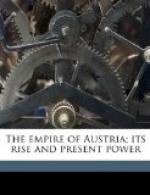Germany was still agitated by the great religious contest between the Catholics and the Protestants, which divided the empire into two nearly equal parties, bitterly hostile to each other. Various fruitless attempts had been made to bring the parties together, into unity of faith, by compromise. Neither party were reconciled to cordial toleration, free and full, in which alone harmony can be obtained. In all the States of the empire the Catholics and the Protestants were coming continually into collision. Charles, though a very decided Catholic, was not disposed to persecute the Protestants, as most of his predecessors had done, for he feared to rouse them to despair.
England, France, Austria and Spain, were now involved in an inextricable maze of diplomacy. Congresses were assembled and dissolved; treaties made and violated; alliances formed and broken. Weary of the conflict of arms, they were engaged in the more harmless squabbles of intrigue, each seeking its own aggrandizement. Philip V., who had fought so many bloody battles to acquire the crown of Spain, now, disgusted with the cares which that crown involved, overwhelmed with melancholy, and trembling in view of the final judgment of God, suddenly abdicated the throne in favor of his son Louis, and took a solemn oath that he would never resume it again. This event, which surprised Europe, took place on the 10th of February, 1724. Philip retired to St. Ildefonso.
The celebrated palace of St. Ildefonso, which became the retreat of the monarch, was about forty miles north of Madrid, in an elevated ravine among the mountains of Gaudarruma. It was an enormous pile, nearly four thousand feet above the level of the sea, and reared by the Spanish monarchs at an expense exceeding thirty millions of dollars. The palace, two stories high, and occupying three sides of a square, presents a front five hundred and thirty feet in length. In this front alone there are, upon each story, twelve gorgeous apartments in a suite. The interior is decorated in the richest style of art, with frescoed ceilings, and splendid mirrors, and tesselated floors of variegated marble. The furniture was embellishcd with gorgeous carvings, and enriched with marble, jasper and verd-antique. The galleries were filled with the most costly productions of the chisel and the pencil. The spacious garden, spread out before the palace, was cultivated with the utmost care, and ornamented with fountains surpassing even those of Versailles.
To this magnificent retreat Philip V. retired with his imperious, ambitious wife. She was the step-mother of his son who had succeeded to the throne. For a long time, by the vigor of her mind, she had dominated over her husband, and had in reality been the sovereign of Spain. In the magnificent palace of St. Ildefonso, she was by no means inclined to relinquish her power. Gathering a brilliant court around her, she still issued her decrees, and exerted a powerful influence




